Background
Erdheim-Chester disease (ECD) is a rare, non-Langerhans cell histiocytosis (LCH) characterised by systemic infiltration of foamy CD68+CD1a− histocytes, belonging to haematological disease.1 The precise incidence of ECD remains elusive, owing to its rarity, inadequate diagnosis and the absence of population-based studies.2 Since 1930, approximately 1500 cases have been reported globally, primarily concentrated in Europe and the USA.1 2 ECD presents with a wide spectrum of clinical manifestations, ranging from mild, indolent lesions to severe, life-threatening organ damage, often involving multiple organs.1 2 More than 80% of patients with ECD harbour mutations that activate the MAPK (RAS-RAF-MEK-ERK) and phosphatidylinositol 3-kinase (PI3K)-Akt pathway, with the BRAFV600E mutation being predominant in about 60% of cases, followed by MAP2K1 in 10%–20% of cases,1 2 providing the first target therapy in histiocytosis named BRAF inhibitor (figure 1).
” data-icon-position data-hide-link-title=”0″>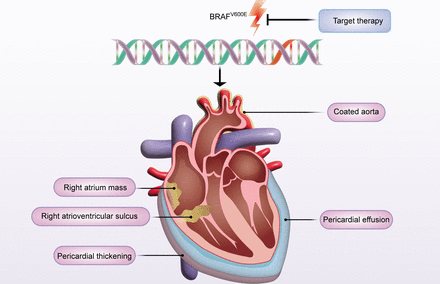

Schematic illustrative figure showing sites of cardiac involvement in Erdheim-Chester disease, along with BRAFV600E mutation and its targeted therapy.
Nearly half of the individuals with ECD experience cardiac involvement, making it one of the most commonly affected organs aside from the bones.3 4 Patients with ECD with cardiac involvement display diverse clinical and radiological characteristics, often susceptible to underdiagnosis.5 In the largest cohort study of patients with ECD with cardiac involvement, the baseline cardiac magnetic resonance (MR) observations were meticulously described, which highlighted the characteristic imaging findings such as atrium and infiltration (figure 1).5 They also first assessed heart treatment response using MR in a long follow-up,6 prior knowledge primarily stemmed from case reports or series. However, 18F-fluorodeoxyglucose positron emission tomography (18F-FDG-PET) characteristics of heart involvement and response were poorly understood.
We delineated the clinical manifestations, imaging features of ECD with cardiac involvement, amalgamating echocardiogram, cardiac MR and 18F-FDG-PET examinations within our single-centre cohort. Our study pioneers the investigation of cardiac treatment response based on pericardial effusion response and heart metabolic response by comparing baseline and post-treatment images.
Methods
Patients
Patients diagnosed with ECD at Peking Union Medical College Hospital, China, between January 2010 and August 2023, were identified from our institutional database. The pathological diagnosis of ECD was confirmed by two experienced pathologists of Peking Union Medical College Hospital according to the WHO classification of tumours.7
Patient and public involvement
Not involved.
Data collection
Clinical data, including demographics, presentation, concurrent conditions, laboratory tests and imaging (CT, MR and 18F-FDG-PET), were extracted from medical records. Treatment details and outcomes were also recorded. Genetic mutations, including BRAFV600E and others, were identified using next-generation sequencing (NGS) or PCR.8
Evaluation of cardiac involvement by images
Diagnosis of cardiac involvement relied on one of the following criteria: (1) disease confirmed by heart biopsy or (2) biopsy of other organs combined with typical imaging indications observed on echocardiogram, cardiac MR or 18F-FDG-PET. Findings involve atrial or right atrioventricular sulcus infiltration and pericardial abnormality include enhancement, infiltration, effusion exceeding 5 mm and thickening of the pericardium.3 5 In instances where infiltration extended beyond 5 mm in three dimensions, it was classified as a pseudomass. Pericardial effusion size was assessed via CT or 18F-FDG-PET images, while the cardiac mass diameter was gauged from cardiac MR images.9 Pericardial effusion size was categorised based on a straightforward semi-quantitative CT or 18F-FDG-PET assessment: mild (5–15 mm), moderate (15–25 mm) or large (>25 mm).10 11
Treatment, response and outcome
Systemic therapy was categorised into interferon (IFN)-α, BRAF inhibitors, cytarabine-based chemotherapy and steroids. Cytarabine-based chemotherapy was administered according to the previous study.12
The overall response was evaluated using the modified PET Response Criteria in Solid Tumours (PERCIST) with 18F-FDG-PET.3 13 Patients who were unavailable for PET/CT scans during follow-up were evaluated using the Response Evaluation Criteria in Solid Tumours (RECIST, V.1.1).14 Both were commonly used criteria for tumour response evaluation.
The cardiac mass response was evaluated in accordance with RECIST. Additionally, the cardiac metabolic response was determined using PERCIST. We evaluated pericardial effusion treatment response of ECD based on UK Multi-Centre Study criteria.15 A complete response (CR) was defined as the disappearance of pericardial effusion that lasted for >30 days. A partial response (PR) was noted when the size of pericardial effusion decreased by >50% for over 30 days. Progressive disease (PD) was defined as an increase in the size of pericardial effusion by >25%. Any condition between PR and PD was classified as stable disease (SD). Heart response was evaluated by combining cardiac metabolic response and pericardial effusion response. A heart CR was denoted by both complete metabolic response (CMR) and CR in pericardial effusion response. Heart SD was identified as both stable metabolic disease (SMD) and SD in pericardial effusion response. Heart response between SD and CR was categorised as PR. Heart PD was defined as a progressive metabolic disease (PMD) in cardiac metabolic response or PD in pericardial effusion response. The large vessel response was evaluated according to RECIST.
Patients were regularly followed up until 31 October 2023, which was the last follow-up date. Overall survival (OS) was measured from diagnosis to death or last follow-up, while progression-free survival (PFS) was calculated from diagnosis to PD, relapse or death from any cause. ECD-related cardiac events included cardiac tamponade, acute pericarditis, pericardial constriction, high-degree conduction disorder or myocardial infarction associated with ECD infiltration or effusion, excluding other causes, after ECD diagnosis. Patients without recorded event dates were censored at the last contact date.
Statistical analysis
Descriptive statistics summarised patient demographics and clinical features. Categorical data were expressed as counts and proportions, while continuous data were presented using medians and ranges. Spearman’s rank correlation was used for correlation analyses with ordinal response data. Fisher’s exact test was used for all the compared group differences for categorical variables. The Mann-Whitney U test analysed continuous variables. Kaplan-Meier method generated OS and PFS curves. Statistical analysis employed SPSS software (V.29.0; IBM, Armonk, New York, USA).
Results
Patients
A total of 96 patients with ECD were diagnosed at Peking Union Medical College Hospital between January 2010 and August 2023. Of these, 40 (42%) patients had cardiac involvement and were enrolled in the study.
The median age at diagnosis was 51.5 years (range: 29–66 years). Among the patients, 18 (45%) were male, yielding a male-to-female ratio of 0.82. The median duration from symptom onset to diagnosis was 25.4 months (range: 2.6–138.3). Table 1 displayed the baseline demographics and clinical characteristics. Additionally, one patient was concurrently diagnosed with acute myeloid leukaemia (AML).
The demographics and clinical characteristics of the patients at the time of diagnosis
The median number of involved organs was 6 (range: 2–11). All patients exhibited bone involvement, with 80% also showing infiltration in large vessels. Additionally, 70% had lung involvement, followed by pleural (58%) and retroperitoneal (55%) involvement.
All patients presented with clinical symptoms, categorised into cardiac symptoms (50%), extracardiac symptoms (75%) and non-specific symptoms (35%). The most prevalent cardiac symptoms were shortness of breath (30%) and oedema (30%), followed by chest tightness (28%) and palpitations (10%). However, 20 (50%) patients did not exhibit any cardiac symptoms. Extracardiac symptoms were associated with lesion location, and mainly included bone pain (18%), exophthalmos (15%), diabetes insipidus (13%) and cough (8%). Furthermore, 14 (35%) patients had non-specific symptoms including fever, fatigue, weakness and anorexia.
The BRAFV600E
mutational status was tested in 32 (80%) of the patients, of which 18 (56%) harboured BRAFV600E
mutation, while 14 (44%) exhibited wild-type BRAF genes. In the 22 patients who underwent NGS, the next most frequently observed mutations were in MAP2K1 (3, 14%) and TTN 3 (14%). Additionally, mutations were identified in other genes related to the MAPK and PI3K-Akt signalling pathways, including MAP3K1, EGFR, ERBB3 and ERBB4 (1, 5% each).
A total of 91% of the patients exhibited elevated hypersensitive C reactive protein (hsCRP) levels. Moreover, 77% had elevated erythrocyte sedimentation rate (ESR) (table 1).
Imaging features
Pericardial effusion was observed in 29 patients, constituting 73% of the cohort and emerging as the most prevalent imaging manifestation (figures 2 and 3). Seven (24%) patients exhibited mild effusion, 10 (34%) had moderate effusion, and 12 (41%) displayed a large amount of effusion. Furthermore, 15 patients (38%) presented with pericardial thickening.
” data-icon-position data-hide-link-title=”0″>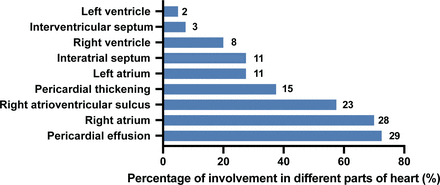

The image findings of involved part of patients with ECD with cardiac involvement, the number of patients involved was annotated behind the columns.
” data-icon-position data-hide-link-title=”0″>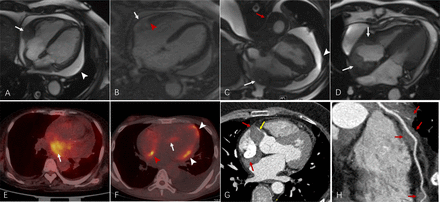

(A–D) Four-chamber cardiac magnetic resonance cine images findings of patients with Erdheim-Chester disease (ECD) with cardiac involvement. (A) Right atrioventricular sulcus pseudomass surrounding right coronary artery (white arrow) and pericardial effusion (white arrowhead). (B) Right atrioventricular sulcus pseudomass (white arrow) and adjacent right ventricular myocardium (red arrowhead) enhancing on enhancement sequence. (C) Right atrioventricular sulcus pseudomass surrounding right coronary artery (white arrow) and pericardial effusion and pericardial thickening (white arrowhead) and coated aorta (red arrow). (D) Right atrium pseudomass (white arrow). (E–F) Positron emission tomography/CT fusion of patients with ECD with cardiac involvement. (E) Left atrium involvement showed 18F-fluorodeoxyglucose (FDG) uptake (white arrow). (F) Right atrium (red arrowhead), interventricular septum (white arrow) and right ventricle (white arrowhead) involvement showed FDG uptake. (G–H) Coronary artery enveloping and stenosis from right atrioventricular sulcus infiltration on CT scan. (G) The pseudomass at the right atrioventricular sulcus (red arrow) encases the origin of the right coronary artery (RCA), leading to RCA stenosis (yellow arrow). (H) The infiltration surrounds the left anterior descending artery without causing narrowing at this level.
Figure 2 illustrates the distribution of specific cardiac involvements. The right atrium was most frequently affected, in 28 cases (70%), followed by the right atrioventricular sulcus in 23 cases (58%), which frequently developed pseudomasses (figure 3A-F). Twenty-one (53%) patients had right atrium pseudomass and 18 (45%) patients had right atrioventricular sulcus pseudomass, enveloping the coronary artery in some instances (figure 3). Notably, this envelopment caused coronary artery stenosis in one patient (figure 3G). Other affected regions included the left atrium, interatrial septum, right ventricle, interventricular septum and left ventricle (figures 2 and 3). Furthermore, one patient had mild-to-moderate pulmonary arterial hypertension.
Treatment and response
Among the 40 patients with ECD with cardiac involvement, 37 patients received systemic therapy for ECD. Of these, 28 received IFN-α as first-line therapy and 26 patients performed post-treatment assessment. Regarding the overall response, 24 (92%) showed response, with 4 (15%) achieving CR and 20 (77%) achieving PR. However, one patient had an assessment of SD and another showed progressive disease (PD). Five patients received BRAF inhibitors as first-line treatment, resulting in one CR and four PR. A single patient treated with cytarabine-based therapy achieved PR. Three patients received steroids therapy and both assessable patients exhibited PD. Two patients opted not to undergo therapy based on personal preference.
Among 21 patients with evaluable heart response, 18 (86%) demonstrated benefit (5 CR and 13 PR), while 3 (14%) had SD (table 2, figure 4). Figure 4A illustrates the cardiovascular and overall response among these 21 evaluated patients. Concerning pericardial effusion response, we observed 6 (33%) CR, 10 (56%) PR. Cardiac mass response showed six (33%) PR, without CR. For cardiac metabolic response, 6 (32%) achieved CMR, 10 (53%) achieved PMR. For large vessels, 7 (39%) patients achieved PR, while 11 (61%) maintained SD.
The overall and heart response of patients with Erdheim-Chester disease
” data-icon-position data-hide-link-title=”0″>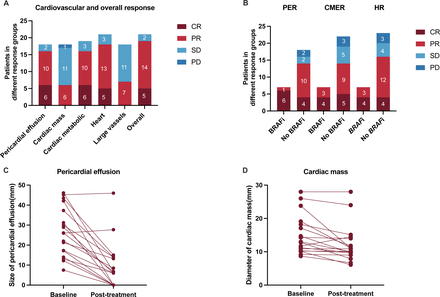

The treatment response of patients with Erdheim-Chester disease with cardiac involvement. (A) The cardiovascular and overall response of 21 evaluated patients who received first-line treatment. (B) The pericardial perfusion response (PER) and cardiac metabolic response (CMER) and heart response (HR) in patients who received BRAF inhibitor or not regardless of treatment lines. The size of pericardial effusion (C) and the diameter of cardiac mass (D) and the diameter change at baseline and after treatment. CR, complete response; PD, progressive disease; PR, partial response; SD. stable disease.
Pericardial effusion response correlated with cardiac metabolic response (r=0.58 (95% CI 0.12 to 0.83), p=0.015), while neither of them correlated with cardiac mass response or large vessel response. Individual changes in pericardial effusion size and cardiac mass diameter were depicted (figure 4C,D). Moreover, figure 5 illustrates two patients (no. 8 (figure 5A–H) and no. 12 (figure 5K–R) in table 2) with both metabolic and effusion CR. One patient had coronary artery stenosis due to soft-tissue mass envelopment, with a noticeable reduction in the right atrioventricular sulcus pseudomass (figure 5I,J) and subsequent recovery from coronary artery stenosis post IFN-α treatment (figure 5S,T).
” data-icon-position data-hide-link-title=”0″>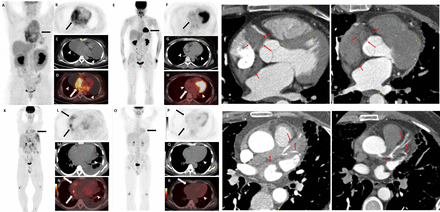

Two patients achieved heart response including heart complete metabolic response (CMR) and pericardial effusion complete response and one patient achieved coronary artery stenosis rescued. (A) The maximal intensity projection (MIP) image showed the baseline 18F-fluorodeoxyglucose (FDG) uptake in the heart of patient 1 (arrow). The axial image (B: positron emission tomography (PET); C: CT; D: PET/CT fusion) showed the baseline FDG uptake of left atrium, interatrial septum, right atrium, right atrioventricular sulcus and pericardium (arrow), and large amount of effusion (arrowhead). (E) The MIP showed the post-treatment image of patient 1 (right ventricle physiological uptake was shown, arrow). The axial image (F: PET; G: CT; H: PET/CT fusion) showed heart CMR (arrow). The effusion totally disappeared (arrowhead). (I, J) Coronary artery CT angiography (CTA) showed the right atrioventricular sulcus pseudomass (red arrows) surrounding the beginning of coronary artery at baseline (I) and (J) after treatment. (K) The MIP showed the baseline FDG uptake in the heart of patient 2 (arrow). The axial image (L: PET; M: CT; N: PET/CT fusion) showed the baseline FDG uptake of left atrium, interatrial septum, right atrium, right atrioventricular sulcus (arrow) and mild effusion (arrowhead). (O) The MIP showed the post-treatment image of patient 2. The axial image (P: PET; Q: CT; R: PET/CT fusion) showed heart CMR (arrow). The mild effusion disappeared (arrowhead). (S, T). Coronary artery CTA showed the left anterior descending artery (red arrows) at baseline (S) and after treatment (T).
Survival and cardiac outcomes
The median follow-up time for the cohort was 50.2 months (range: 1.0–102.8 months). A total of eight patients died, including one patient who died of concurrent AML and seven who died from ECD progression. The estimated 3-year and 5-year OS was 86.2% and 78.9%, respectively (figure 6A). Among the 37 patients who received systemic therapy, 14 experienced PD. The median PFS was 59.4 months (95% CI 26.2 to 92.7 months).
” data-icon-position data-hide-link-title=”0″>

(A) Overall survival (OS) of 40 patients and progression-free survival (PFS) of 37 patients received systemic therapy. (B) The first-line treatment of and heart response of 21 patients and the following heart response of 10 patients who suffered disease progression, 9 of them received second-line treatment and heart response assessment referred to second-line treatment and heart response. One patient maintained heart PR but suffered central nervous system disease progression and received Arac treatment as second-line therapy. Arac, cytarabine-based treatment. BRAFi. BRAF inhibitors. CR, complete response; IFN-α, interferon-α; PD, progressive disease; PR, partial response; SD, stable disease.
In the subsequent follow-up, 13 of 21 evaluable patients experienced overall PD, 10 of whom had assessable cardiac results (figure 6B). Nine displayed heart progression, while one maintained remission but suffered central nervous system PD (table 2, figure 6B).
Nine patients underwent second-line treatment: four received BRAF inhibitors, three received cytarabine-based treatment and two continued IFN-α due to economic constraints. Patients received BRAF inhibitors as second-line treatment showed three CR and one PR. Among those not treated with BRAF inhibitors, one showed PR, one SD and three PD. Based on first-line and second-line response, patients receiving BRAF inhibitors achieved better heart response (p=0.037), as well as better pericardial effusion response (p=0.009) and cardiac metabolic response (p=0.048) (online supplemental table 1, figure 4B). No difference was observed in cardiac mass, vessel or overall response between groups (table 2, figure 4).
Supplemental material
Additionally, the pericardial effusion response to second-line treatment strongly correlated with metabolic response (r=1.00, p<0.001). A persistent positive correlation (r=0.73 (95% CI 0.46 to 0.88), p<0.001) between pericardial effusion and cardiac metabolic response was evident (online supplemental figure 1), while other response indicators did not exhibit significant correlation.
Regarding ECD-related cardiac event, one patient experienced chronic cardiac tamponade and two patients developed pericardial constriction requiring surgery. Another patient presented with secondary sick sinus syndrome, necessitating a pacemaker implantation recommendation. Additionally, one patient suffered from a myocardial infarction.
Discussion
We described the clinical manifestations, imaging features, treatment response and outcome of patients with ECD with cardiac involvement within our large single-centre cohort. This was one of the largest cohort studies specifically examining cardiac involvement. We evaluated heart response based on pericardial effusion and heart metabolic response. Furthermore, we provided a comprehensive illustration of changes in cardiac mass size and large vessel infiltration.
Previous large cohort studies found that 40%–50% patients with ECD had the cardiac involvement,1 5 Notably, nearly 80% of patients with cardiac involvement also exhibited concurrent large blood vessel involvement, significantly higher than those without cardiac involvement.5 16 This corresponds with our own findings,17 suggesting a potential association between the occurrence of cardiac and vascular involvement.
The most common cardiac imaging findings of ECD include right atrial infiltration, atrioventricular sulcus infiltration and pericardial effusion, reported to range approximately between 65%–75%, 48%–73% and 50%–60%, respectively.5 16 18 19 In our study, the rate of pericardial effusion was slightly higher, at 73%. We observed similar percentages for right atrial pseudomasses (70.0%) and atrioventricular sulcus infiltration (58%) compared with previous reports. Unexplained pericardial effusion and unexplained right atrial mass and atrioventricular sulcus infiltration should raise a high suspicion of ECD. Notably, involvement of the left ventricle, interventricular septum and right ventricle were also detected, which has been scarcely mentioned in earlier studies. This may be attributed to our evaluation using both cardiac MRI and 18F-FDG-PET. 18F-FDG-PET can enhance lesion detection, particularly for lesions characterised by increased metabolic activity.
Regarding the BRAF mutational status, two extensive studies have highlighted an association between cardiac involvement and the BRAFV600E
mutation.5 18 They reported mutation rates ranging from 81% to 84%, significantly higher than in wild-type cases. The pathophysiological explanation for this association remains unclear. However, only 56% of our patients exhibited the BRAFV600E
mutation, and we did not observe a clear correlation. Larger-scale and multi-ethnic investigations are needed to further explore and clarify the relationship between cardiac ECD and BRAF mutational status.
The overall response rate observed in our cohort aligned with systemic therapy regimens mainly involving IFN-α, BRAF inhibitors.3 20 21 However, studies specifically evaluating treatment response in cardiac involvement were scarce, primarily limited to a few case reports.6 16 The study by Azoulay et al stands out as the only cohort study investigating regression of cardiac involvement in ECD. They effectively showcased regression of cardiac infiltration following long-term treatment, providing both visual and semi-quantitative cardiac imaging data.6 However, anatomical size alone may not fully capture organ response, given the incomplete regression of tissue fibrosis that can occur with ECD,3 22 which was also evident in the cardiac and vascular responses in our cohort. Consequently, we incorporated 18F-FDG-PET to provide a metabolic activity assessment of response.
In clinical practice, including our cohort, several patients may achieve CMR on imaging or show no uptake at baseline yet still exhibit considerable pericardial effusion. This can lead to symptoms and occasionally require repeated punctures. In these scenarios, relying solely on the PERCIST criteria may be inadequate for assessment. We thus specifically evaluated pericardial effusion response in ECD and integrated it into heart response assessment. Our study stood as the first to evaluate heart response in a cohort based on both cardiac metabolic response and pericardial effusion response.
The study by Azoulay et al included patients with at least two CMR exams, providing valuable continuous cardiac imaging data over long-term follow-up.6 Additionally, patients tended to receive multiple lines of systemic treatment. In our study, we tracked the first-line and second-line treatment responses, and the heart response of patients after first PD events. This expanded our understanding of PD manifestations. Among the 10 patients experiencing overall PD, 9 had heart progression, predominantly exhibiting PMD. Interestingly, only four patients had pericardial effusion progression, and three displayed cardiac mass progression, suggesting metabolic progression may manifest initially in the heart, while certain anatomical responses are sustained at that time.
Azoulay et al reported a higher heart response rate in patients receiving BRAF inhibitors, with superior outcomes when used as frontline treatment. Similarly, patients in our cohort treated with BRAF inhibitors achieved better heart response rates regardless of treatment lines. As second-line therapy, BRAF inhibitors led to a 75% CR rate and further alleviation of pericardial effusion. However, most mass responses of heart and large vessels remained SD, and two patients experienced PD. This illustrates that achieving mass regression may be more challenging even with BRAF inhibitors.
Pericardial effusion and cardiac metabolic responses exhibited a degree of parallelism in both first-line and second-line treatments, but showed no correlation with tumour mass response. This implies that heart metabolic response can be predicted by pericardial effusion response to some extent. Consequently, serial PET-CT evaluations at every follow-up may be unnecessary; preliminary heart response assessment could be obtained via CT, MR or echocardiography.
As in previous studies,5 18 20 cardiac involvement was not associated with poorer prognosis. In our cohort, the 5-year OS was 78.9% and the median PFS was 59.4 months, consistent with other studies.1 3 5 18 Larger cohorts are essential for comprehensive prognosis analyses.
There are limitations given the single-centre retrospective design, including missing cardiac MRI data in some evaluations, potentially introducing bias. Sample size also constrained prognostic analyses, which may bring bias, especially for observational study. Small sample size also made results less robust, reflected in the wide CIs. Larger, multicentre cohorts with extended follow-up will enable more comprehensive investigations.
- The Renal Warrior Project. Join Now
- Source: http://heart.bmj.com/cgi/content/short/110/13/899?rss=1
